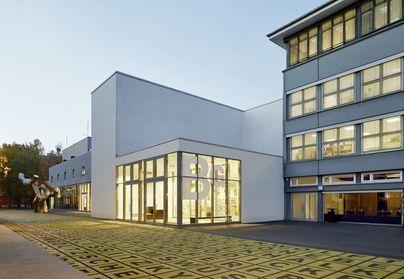Sporting a long bushy beard, Julius von Bismarck says there is “no way to avoid dealing with the name.” He means his own—and that of Otto von Bismarck, the first chancellor of the German Empire and the artist’s great-great-great-great-uncle. “It is everywhere; entire landscapes, seas, and 12 streets in Berlin have the name.”
Bismarck’s When Platitudes Become Form is showing until 14 August at the Berlinische Galerie, which reopens today after closing for four months to upgrade its lighting. The museum’s new exhibitions are dominated by the theme of mankind’s relationship with the environment; the art on show includes a life-sized (but not life-like) moving giraffe, several stuffed animals and a spaceship shaped like a lotus flower.

Nasan Tur, Shadow (2023) © VG Bild-Kunst, Bonn 2023
There are no fewer than five new shows: alongside Bismarck’s exhibition, Nasan Tur’s Hunted is showing until 1 April 2024; a show about 1970s construction in Berlin called Suddenly Wonderful runs until 18 September; The Sweet Certainty by the duo Matthias Böhler and Christian Orendt is on until 23 August, and Pinar Ogrenci’s video work The Avalanche can be seen until 31 July.

A film still from Pınar Öğrenci’s Aşît (2022) © Pınar Öğrenci
Bismarck shows his chancellor forebear on horseback, as he is portrayed in a Bremen statue. Next to him is the giraffe, also on a pedestal. It is a giant, jointed model of a children’s toy—the type with a round base that when pressed, causes the creature to move in unnatural spasms and fold together. Bismarck and his horse also jerk precariously on their pedestal, apparently about to collapse.
The name is a thread running through Bismarck’s exhibition. Another large installation, I Like the Flowers, features a roomful of giant pressed palm trees suspended from the ceiling, including a species from Madagascar known as the Bismarck Palm. In their ornamental, one-dimensional beauty, the trees give the illusion of fragility (they are in fact mounted on steel). An abstract painting on a nine-meter by 12-meter cloth showing stripes of movement on the surface of the Bismarck Sea billows gently from the ceiling. A photograph shows the cloth floating on the waves off Papua New Guinea.

Julius von Bismarck, I like the flowers (Strelitzia Nicolai, 2017) Courtesy Julius von Bismarck; alexander levy, Berlin, and Sies + Höke, Düsseldorf, © Julius von Bismarck, VG Bild-Kunst, Bonn
Tur’s work explores people who kill animals for sport—in a video, they anonymously answer the artist’s dispassionate questions about how and why they hunt, and what emotions they experience when they shoot an animal. Spread across another large gallery are four stuffed animals – a fox, deer, boar and bird of prey—lying unceremoniously on the floor at the feet of visitors. In contrast with the lifelike poses of traditional taxidermy, they are shown as corpses, arousing the same mix of revulsion and sorrow as dead animals glimpsed on the roadside.
A huge, complex installation by Böhler & Arendt shows a giant ape-like figure lying in a foetal position while teams of tiny men run around it with ladders, digging equipment and wagons on rails to tap the resources it offers. In a second room, their 2020 lotus-flower space ship offers The Sweet Certainty of Deliverance from the Darkness that Surrounds Us.
The Berlinische Galerie has purchased nine images shown inside the spaceship which portray this magical deliverance for its own collection.

























